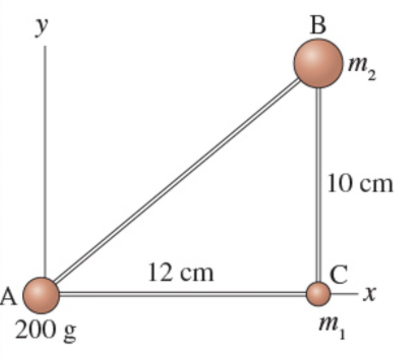Question
In: Physics
The three masses shown in (Figure 1) are connected by massless, rigid rods. Assume that m1 = 180 g and m2 = 350 g.
The three masses shown in (Figure 1) are connected by massless, rigid rods. Assume that m1 = 180 g and m2 = 350 g.

What is the x-coordinate of the center of mass?
Express your answer with the appropriate units.
What is the y-coordinate of the center of mass?
Express your answer with the appropriate units.
Solutions
Expert Solution
Concepts and reason
The main concepts required to solve this problem are the center of mass and distance. Initially, write the equations for the \(x\) and \(y\) -coordinates of the center of mass of the system of three masses. Use this equation and calculate the x-coordinate of the center of mass and y-coordinate of the center of mass of the three masses system.
Fundamentals
Center of mass can be defined as the point in which all the particles of the masses of the system is supposed to be concentrated. The x-coordinate of the center of mass of the system of three masses is, \(x_{C M}=\frac{m_{1} x_{1}+m_{2} x_{2}+m_{3} x_{3}}{m_{1}+m_{2}+m_{3}}\)
Here, \(m_{1}\) is the first mass, \(m_{2}\) is the second mass, \(m_{3}\) is the third mass, \(x_{1}, x_{2},\) and \(x_{3}\) are distances of the three masses from the origin respectively in x-axis. The y-coordinate of the center of mass of the system of three masses is, \(y_{C M}=\frac{m 1 y 1+m 2 y 2+m 3 y 3}{m_{1}+m_{2}+m_{3}}\)
Here, \(y_{1}, y_{2}\) and \(y_{3}\) are the vertical distances of the three masses from the origin respectively.
(A) The equation for the x-coordinate of the center of mass of the three masses system is, \(x_{C M}=\frac{m_{1} x_{1}+m_{2} x_{2}+m_{3} x_{3}}{m_{1}+m_{2}+m_{3}}\)
Substitute \(180 \mathrm{~g}\) for \(m_{1}, 12 \mathrm{~cm}\) for \(x_{1}, 350 \mathrm{~g}\) for \(m_{2}, 12 \mathrm{~cm}\) for \(x_{2}, 200 \mathrm{~g}\) for \(m_{3},\) and 0 for \(x_{3}\) in above equation.
$$ \begin{array}{c} x_{C M}=\frac{(180 \mathrm{~g})(12 \mathrm{~cm})+(350 \mathrm{~g})(12 \mathrm{~cm})+(200 \mathrm{~g})(0)}{(180 \mathrm{~g})+(350 \mathrm{~g})+(200 \mathrm{~g})} \\ =8.71 \mathrm{~cm} \end{array} $$
Part A The x-coordinate of the center of mass of the three masses is \(8.71 \mathrm{~cm} .\)
Explanation \(\mid\) Common mistakes | Hint for next step
Here, the x-coordinate of the center of mass of the three masses is depending on their masses and their distances from the origin in x-axis. The horizontal distance of the mass \(\mathrm{m} 3\) is 0 because the third mass is located at the origin.
(B) The equation for the y-coordinate of the center of mass of the three masses is, \(y_{C M}=\frac{m_{1} y_{1}+m_{2} y_{2}+m_{3} y_{3}}{m_{1}+m_{2}+m_{3}}\)
Substitute \(180 \mathrm{~g}\) for \(m_{1}, 0\) for \(y_{1}, 350 \mathrm{~g}\) for \(m_{2}, 10 \mathrm{~cm}\) for \(y_{2}, 200 \mathrm{~g}\) for \(m_{3},\) and 0 for \(y_{3}\) in above equation.
$$ \begin{array}{c} y_{C M}=\frac{(180 \mathrm{~g})(0)+(350 \mathrm{~g})(10 \mathrm{~cm})+(200 \mathrm{~g})(0)}{(180 \mathrm{~g})+(350 \mathrm{~g})+(200 \mathrm{~g})} \\ =4.79 \mathrm{~cm} \end{array} $$
Part B The y-coordinate of the center of mass of the three masses is \(4.79 \mathrm{~cm}\).
Explanation | Common mistakes
Here, the y-coordinate of the center of mass of the three masses is depending on their masses and their distances from the origin in y-axis.
Part A
The x-coordinate of the center of mass of the three masses is \(8.71 \mathrm{~cm}\)
Part B
The y-coordinate of the center of mass of the three masses is \(4.79 \mathrm{~cm}\).
Related Solutions
Three 90.790.7 g masses are connected in a triangular shape by massless rigid wires as shown...
Three 81.6 g masses are connected in a triangular shape by massless rigid wires as shown...
Two boxes with masses m1=5.0 kg and m2=3.0 kg are connected by a massless rope, which...
Two objects with masses of m1 = 3.20 kg and m2 = 7.90 kg are connected...
Two blocks (m1=3kg, m2=7.8kg ) are connected by a string that passes through a massless pulley...
Four point masses are arranged as follows: m1 = 5.76 g at (0,19.6 cm), m2 =...
In the figure below, three thin rods are all connected at their centers.
1. Suppose we have two blocks of masses m1 and m2. The block with mass m1...
Let's consider a rigid system with three particles. Masses of these particles m1 = 3 kgs,...
As shown in the figure below, two blocks (m1 and m2) are each released from rest...
- STRICT DOWNVOTE IF NOT DONE FULLY, WILL REPORT ALSO IF COPY PASTED OR MODIFIED ANSWER Develop...
- The three questions are basically looking for an observation, asking the question and then giving the...
- YOU are the financial officer at an Austrian company that wants to BUY USD 1.000.000 of...
- Please read the whole program (all the way to the bottom), Thanks in advance! Develop car...
- A)Consider the following gases, all at STP: Ne, SF6, N2, CH4. Which gas is most likely...
- Coors and Anheuser-Busch (Budweiser) are competing against each other to try to capture a larger share...
- a) How much heat is required to change a 31.3 g ice cube from ice at...
 Dr. OWL answered 4 years ago
Dr. OWL answered 4 years ago